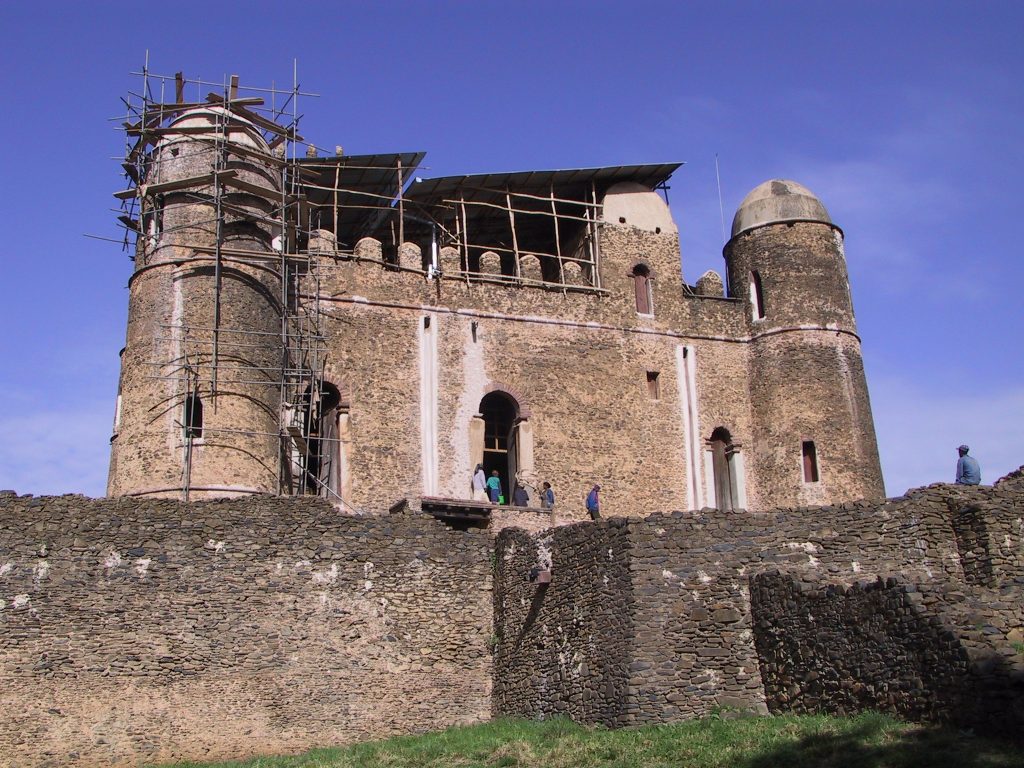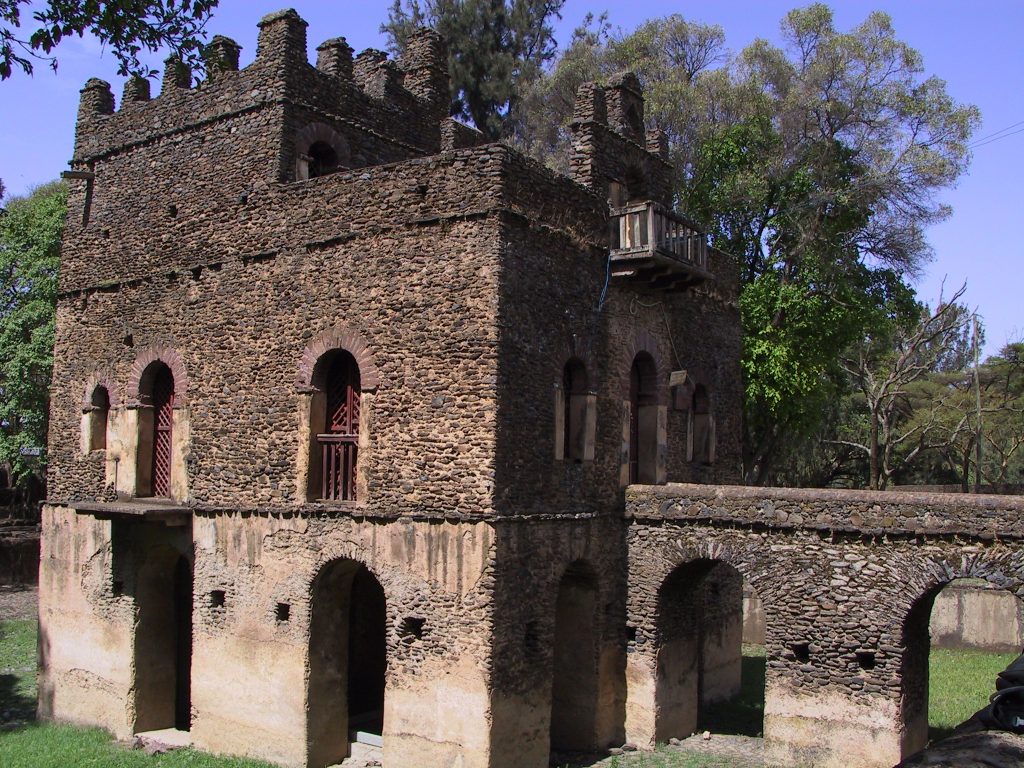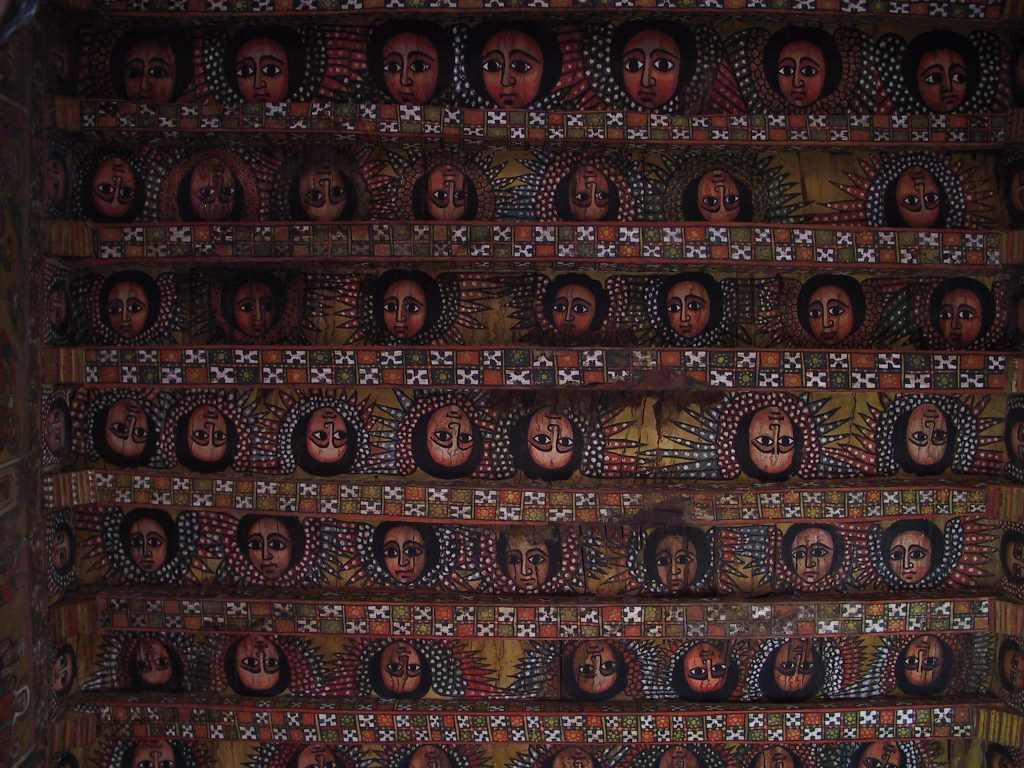Map and Information on Ethiopia, Click Here
Entered Ethiopia 21st May 2001.
Exchange Rate: 1USD = 8.437 Birr (B)
Fuel: 1 Litre = B4.3 (Regular, unknown octane)
Camping: B25
Hotels: – From B10-B50 for a single room.
Road conditions: – Sealed roads ranged from great to poor. All dirt roads are really rocky. Destroy rims type rocky. Extreme caution required.
Speed limits: – No Idea!
Border crossings: Only one from Kenya at Moyale, one to Sudan at Gallabat, one to Djibouti at Yoboki. You can not legally cross into Eritrea directly from Ethiopia, only via Djibouti, but I have heard it is physically possible just north of Axum.
Food & Drink: – 1.5L Mineral Water B15, .66L Carbonated water (Ambo) B3, 330ml Beer B4, 330ml Pepsi B3, Main Meal B10.
If you are old enough, I’m sure you will recall the devastating famine that Ethiopia suffered in the mid 1980’s. It was hard to forget. Hundreds of thousands of people sitting out in a flat, desolate, dusty plain without shelter or water, waiting for food, or to die, whichever came first. Let me dispel any images you have of Ethiopia being a desert waste land. Yes, it does have desert areas, but the fact is the most of the land is very fertile, with good reliable rainfall, and even has true rainforests. The geography is dominated by a mountainous plateau at predominant altitudes of between 2500-3000m, with the Rift valley running down the middle. Riding up from Kenya to the capital Addis Ababa, the altitude started at about 1400m and quickly rose to 3000m, through cool misty rain, and green cultivated rolling hills. Later, the road descends back down to the dryer Rift valley lake area, which supports a wide variety of bird life, then ascends again to Addis Ababa at about 2400m, making it the third highest capital city in the world.
Ethiopia is predominantly Christian, but their version has developed relatively independently from European Christianity, and can be traced back to the 4th century AD. They do have modern saints like St George, the dragon killer (never mind the fact that dragons are fictional, so does that make him a fake?). It would be interesting to compare their bible to ours.
The biggest challenge to riding in Ethiopia is, like Asia, the animals and carts on the road, but unlike Asia, there are few trucks, and even fewer cars. In the country, people seem to spend their lives going up and down the roads; herding their sheep, goats and cattle to new pastures; leading donkeys with loads of firewood and grain; horse drawn sulkies for transport; or just stand in the middle of the road to have a discussion with friends. Driving through towns is an experience. They all stand in the middle of the road, and you need to toot your horn to get them to move. Even though I was being very careful, I came close to hitting people twice. Both looked me in the eye, then walked in front of the bike and I had to use every bit of brakes I had. They definitely have better road sense in the rest of Africa, though not too much better. Probably the closest I came to losing the bike was when an idiot goat (is there any other kind?) freaked out in front of me while I was on really loose shale. I hit the brakes and lost the front end. I had to use a major dab with my left foot to kick it back up, and nearly had my leg dragged under the pannier for my trouble. It occurred to me then that it would be really easy to break your leg on a pannier, which I later found is exactly what happened to Ted Simon (Jupiters Travels) in Northern Kenya. Ted is a ‘real’ writer, and if you enjoy adventure travels, check out the link.
All the travel books will warn you about the difficulties travelling in Ethiopia. The people yell ‘YOU YOU!’, and ‘FARANJI!’ (foreigner) all the time. Beggars and would-be guides are prolific. After where I’ve been, I didn’t think it would faze me too much, but by the time I left, I had had about all I could take. The yelling didn’t bother me at all; at least they don’t throw stones (that is to come in Sudan). The guides really got to me. You can’t be on your own for more than a minute without someone starting to talk to you. For quite a while, I persisted, hoping that someone wants to actually talk, but they are all selling something, be it guiding services, a hotel, a restaurant, drugs, whatever. You just can’t relax and enjoy what you are seeing because you are too busy fending people off. In the end when they started talking to me I would just say “I don’t need a guide and I DON’T WANT a guide”. One of their favourite lines is ‘How can I help you?’, to which I gave an exasperated reply “You can’t!”. This harassment will turn a lot of potential tourists off coming here, and unless the problem is controlled like they do in the historical cities of Morocco, it will kill the tourist trade.
The beggars are the worst I have seen anywhere. They follow you around simpering unintelligible murmurings, and really do all the can to make you feel bad. I realise this sounds very harsh, and these people are in dire straights, but the never ending fending off is wearing. I just can’t help them all. After coming from Uganda, where the guides and beggars only ask once, this place is a real challenge.
I have a policy with beggars. I only give to ‘genuine’ cripples and the elderly, never anything to children, because that encourages them to be life long beggars. In some places like India, there was a practice of horribly mutilating babies while their bones were soft enough, so that they could beg to feed the family. There you have to think twice about giving to cripples, because you could be justifying the next mutilation. In some Muslim countries, younger women are valid beggars because once a woman is divorced or widowed, she has virtually no job or husband prospects.
Travelling around, the people are mostly friendly. About 50% smile and wave, the other 50% shove out their hand implying ‘GIVE ME!’ I heard from some aid workers here that many of the current generation of Ethiopians are so used to getting aid from foreign counties, they now expect it as a right. In many arid areas, food is given out every week, and has been since 1986. I don’t understand it. If they can’t grow enough to be self-sufficient in good seasons, should they be there at all? Is the rest of the world going to have to support them forever? What will happen to them if we can’t support them one year? They will surely starve, so is what’s happening right now the wise thing to do?
I should qualify what I have just said here because my bad experiences were limited to the northern historical circuit (Lalibella, Bahir Dar and Gonder), and I have just come from there as I write this, so the experience is still very fresh, and lastly, and perhaps most significantly is that I have been sick for most of Ethiopia, and no doubt a lower level of tolerance.
Riding through Ethiopia countryside is spectacular, and contrasting. From green rolling hills, to rocky lifeless mountains sides. Without a doubt the best scenery I have seen since South Africa. There are plenty of dirt roads, in fact you can’t avoid them. I did over 1000klm of dirt roads, and most of that mud. Thanks to the mud, I have just blown another set of fork seals. I know how it was caused, and I know now how to stop it in future.
Addis Ababa has an incredibly mild climate. The average daily temperature ranges from just 21° to 26° throughout the year. In fact every night I spent in Ethiopia was quite cold (by my standards). I rode with my warm jacket instead of the summer jacket I used in most of the rest of Africa. I am also decidedly moving into the wet season for this part of the world, and I still have a lot of dirt roads to go. As I came through the section of dirt in Northern Kenya, it was dry, but the next morning when I woke up the sky was black and threatening. On the way to Addis Ababa, I was drenched several times. It was a sealed road all the way of varying quality, but the last 300km is brand new, really wide and fast.
As I was coming into Addis Ababa, I met a local on a Honda 600 Transalp named Anteneh. It turns out he owns two excellent Italian Restaurants, so if you get sick of Ethiopian food, and most travellers do it seems, give him a go. He was extremely helpful to me, a nice guy, and I promise he won’t try to sell you anything! He has a restaurant called Blu Tops (blu means eat in Ethiopian), opposite the National Museum in King George Road, and another called View Tops, with a view believe it or not. Anteneh imported his bike from Italy where he spent a few years working in real Italian restaurants. His was one of only two big bikes I saw. The other was a ratty Yamaha 750 cruiser with extended forks and a knobby front tyre. I’ll bet it handles just great!
When I arrived in Addis Ababa, I felt a bit down. I had done an average of 3000km a week for the last 5 weeks, and still managed to see an incredible amount. When I rode, they were big days. Often around the 1000km mark. I emailed home that I was really getting tired, and not really as eager as I was. I spent a whole day sleeping and reading, then the next night, I went out to a great French restaurant with some English and French overland travellers I met at my hotel. I enjoyed the company and the meal, but I had no appetite. Even a small meal bloated me. I thought I might have something coming on, but that night when I got to my room I started to get an incredible pain in my stomach. I thought I had food poisoning, because I felt nauseous, and over the next few hours, proceeded to empty my stomach several times. By 1am, my stomach was definitely dry, but the pain was still there, in fact getting worse. I thought it might just be colic, and tried to massage my stomach, but it was too painful. I didn’t get any sleep at all that night. I just couldn’t ignore the pain.
By 6am, I was breathing heavy and deliberately, exhausted, in fever, in pain, and not altogether with it. I knew I had to get to a doctor, but where at 6am on a Sunday morning in a 3rd world country? I stumbled out of my room and told one of the security guards I needed a doctor. I don’t think I needed to tell him actually, but he went off and woke up the manager. He was a young guy, and he really looked after me well. He escorted me in a taxi to a doctor in town, handled all the forms, money and talking, took me to the pharmacist, and back. I couldn’t have done it myself. The doctor’s rooms looked 3rd world, and the pathology lab even more so, but they were thorough. After a physical examination, I gave a blood and stool sample, and about 45 minutes later the results were back. I had several nasties in my system including E-coli (food poisoning), but the one that really got my attention is Typhoid. This used to be a killer, but the doctor seemed really nonchalant about it. It seems that these days a 7 day course of antibiotics is all it takes to cure it. He also gave me a pain killing injection, and some pain killing tablets. Neither seemed to work, but after about 11am, the pain subsided enough to sleep.
I checked the health section of my guide book, and I quote “Sanitation related diseases such as giardia, typhoid and hepatitis appear to be a greater threat in Ethiopia than in other parts of eastern and southern Africa.” I have to agree! In fact a greater threat than in most other places on earth! It usually comes from bad water. I am vaccinated against typhoid (but apparently it is not a 100% protection), and I only drink bottled or filtered water. I could only have got it from food, but if the food is cooked properly, it should have be safe. In many places the dishes and glasses are just rinsed in water and not dried before they are used. I think it most likely I caught it this way. The disease effects the gall bladder which is on your right side below the diaphragm (lungs), which explains why even a small meal was making me feel full.
The day I got sick I was supposed to be going to an Ethiopian wedding at the invitation of Anteneh and his girlfriend. I was looking forward to the traditional music and dancing, but it wasn’t to be. After he found out what happened, he dropped in to bring me Italian biscuits, which were a great supplement to my diet of bananas and oranges. There wasn’t much I could digest, but really plain food. I definitely couldn’t eat Ethiopian food. It is very hot and spicy.
I finally managed to get my Sudan visa. After all the hassles everywhere else, it seems Ethiopia is the only place if you are heading north. It takes 3 working days, and requires a letter from your embassy saying absolutely nothing but what is in your passport already!??????? I had to go to the Canadian embassy, because we don’t have one here. It cost me US$37 for a letter that simply said:
I am pleased to introduce Christopher Mark Addison, and Australian citizen. Please extend him all courtesies for his visit to your country from the 1st of June.
Regards, Blah..Blah..
All Islamic countries require a letter, except they usually also require your religion and profession. The embassies will put any religion and profession you like on the letter, so the letter has no credibility anyhow. The letter is mindless bureaucratic nonsense. I asked the consulate why they require the letter, and was given the typically mindless answer of ‘because it is the rules’.
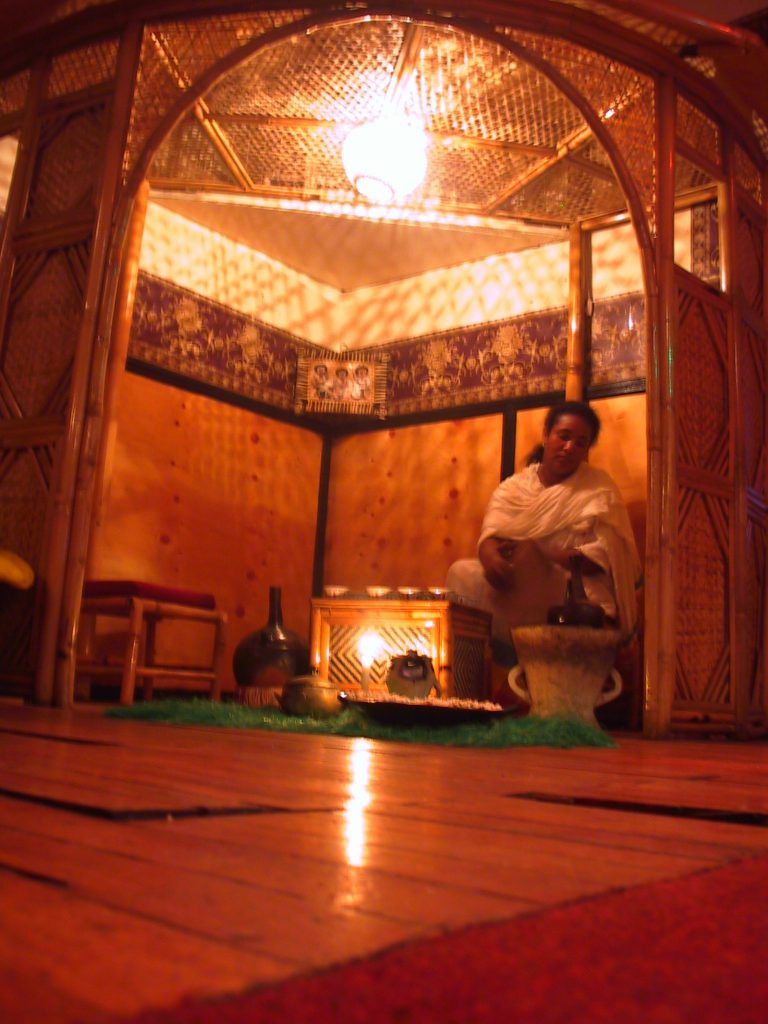
According to one guide book, Ethiopia was the first to ship coffee beans, some 1000 years ago. I had written in my Malawi story that they were the first, so I suppose that the only sure thing is that coffee did come from somewhere in Africa! The traditional coffee ceremony is something you can’t avoid here. It is very common place.
Most towns have cafe’s selling coffee from Italian espresso machines, and pastries. Very cheap. Coffee OK, pastry (cakes mainly) very dry.
Three days after getting typhoid, I decided to move on. I was really getting tired of laying in bed. I had just read James A Michener’s ‘Poland’ novel in 2 days, and I really didn’t feel too bad. Certainly a bit weak, but well enough to ride. After picking up my visa, I did an easy day of 400km to Desse. All sealed road, and the last sealed section I would see for the next 1000 odd km.
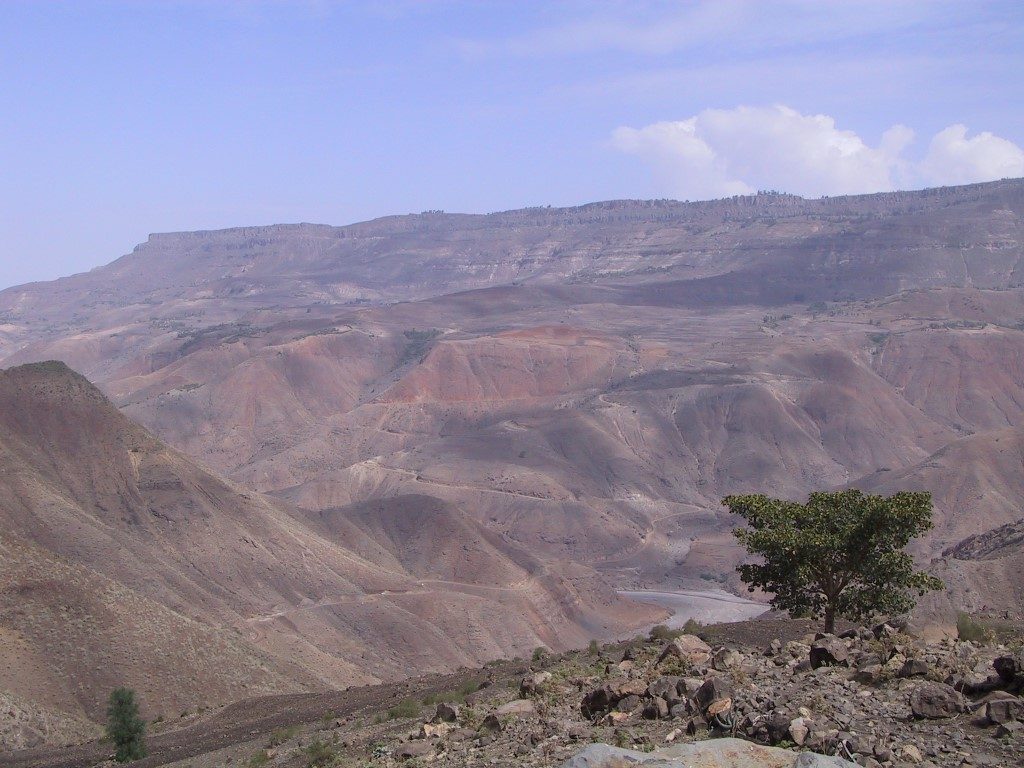
This is an example of the barren, rocky northern highlands. I decided to take the dirt road from Desse to Lalibella, a distance of 265km of dramatic and varying scenery. It was very slow going, averaging only 35km/h, but it was worth it. I wouldn’t recommend doing it without a GPS. The road is not very well defined in places, and several times I was convinced I had missed a turn somewhere. Three times I had to descend from 3000m to1400m and back over slippery shale surfaces.

They were doing major road-works on a long section of this road, but I can’t figure out why. This is a secondary road. There are no mines or major agriculture anywhere I could see. There is already a sealed road in existence, and it doesn’t wind up and down the mountains like this road. It is possible that this is going to be a part of the road upgrade to Sudan, where Ethiopia sources all it’s petroleum products, but this road seems too tight, steep and slippery for oil tankers.
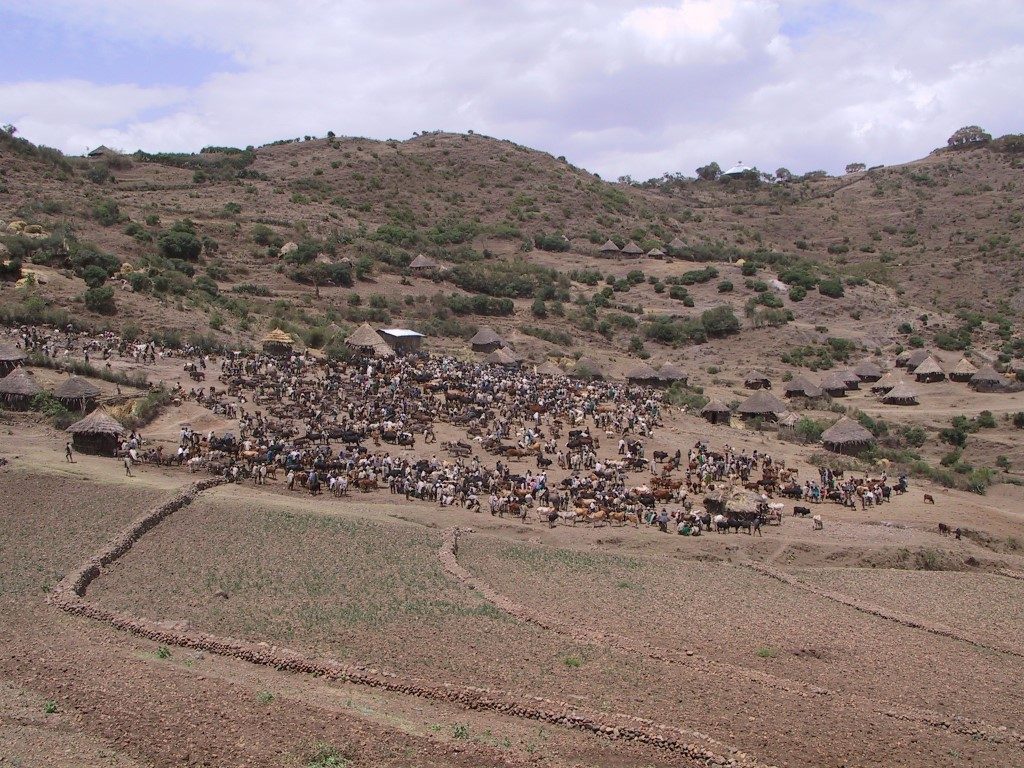
A major animal market on the way to Lalibella. Thousands of people trading cattle and donkeys. This is only a part of the market. The fields in the foreground are incredibly rocky, delineated by rock walls. They plant between the rocks, and somehow manage to get a crop.
Lalibella is a historical town made world famous for it’s rock carved churches. Initiated by King Lalibella in the 11th century, these churches were chiseled from bedrock level down, from one contiguous block of rock. The roof is at ground level. The rock is actually sedimentary (like Australia’s Eyre’s Rock or Uluru), so it isn’t anywhere near as hard as igneous rock such as granite or basalt, but it is a major feat none the less.
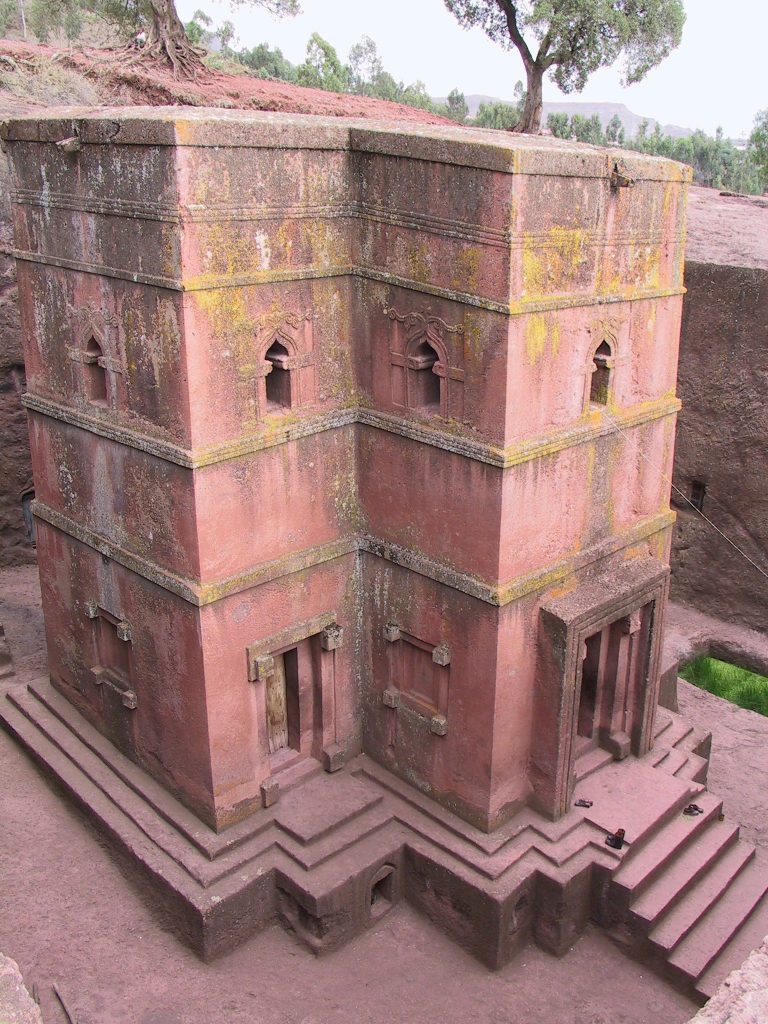
The church of St. George. Very detailed carving. Imagine the care required. Mistakes can’t be repaired, being all from one mass of rock.
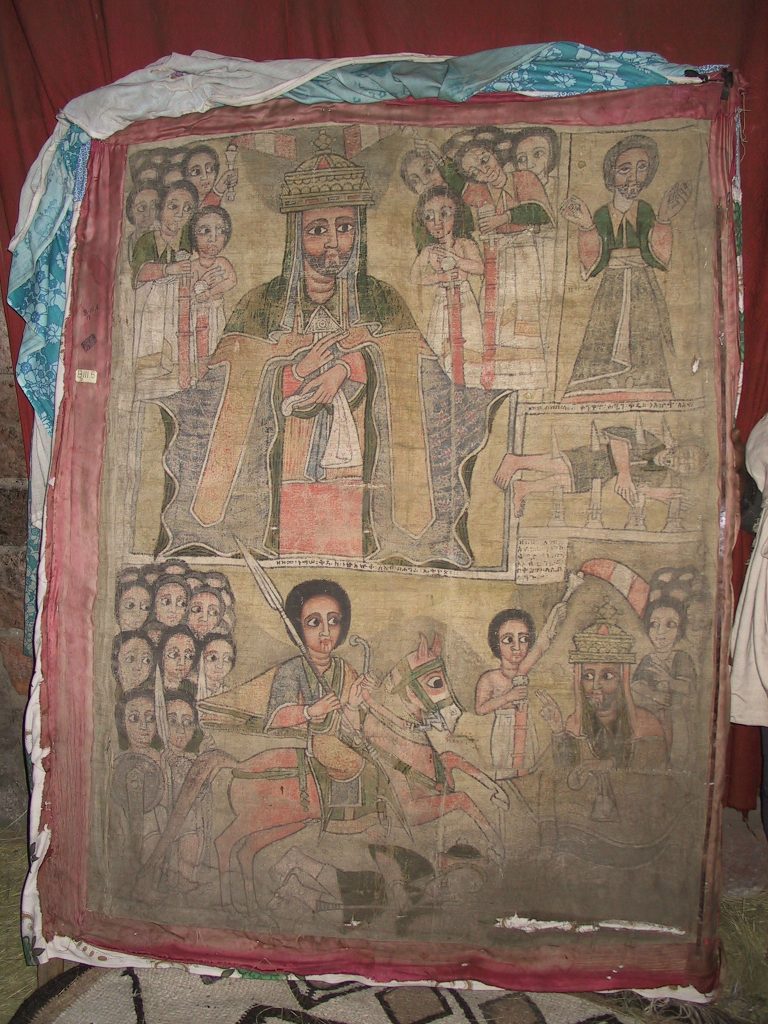
A 900 year old canvas depicting King Lalibella. This is the only original on show. All the others are rather amateurish copies, and the originals stored away.
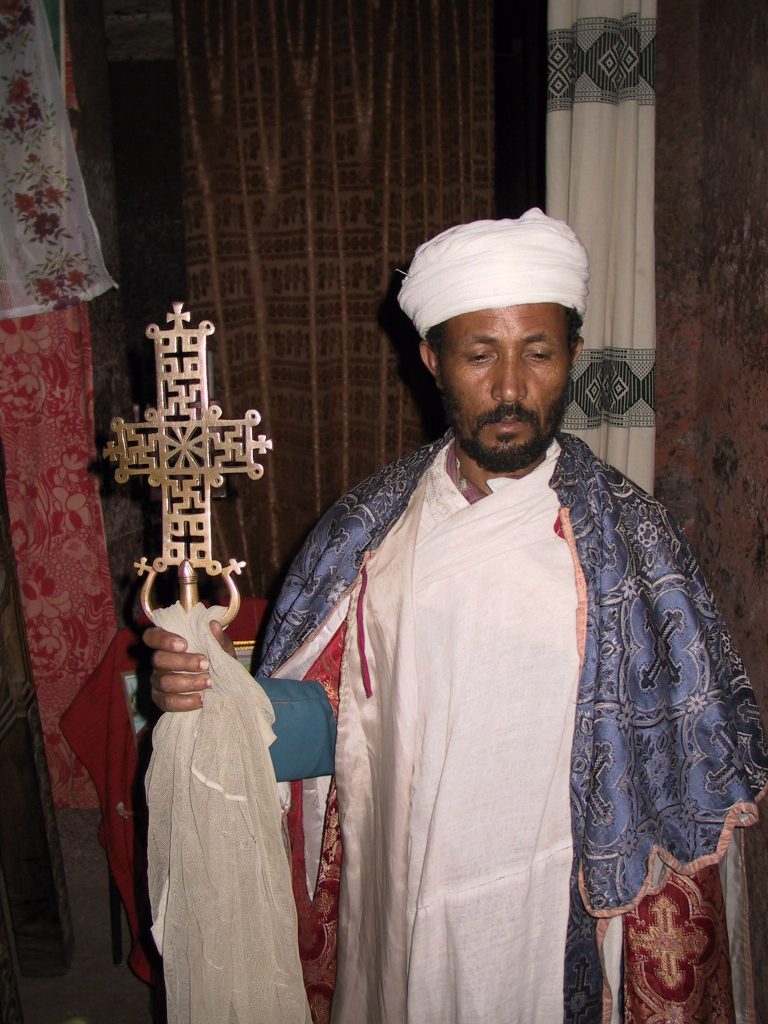
Each church is tended by these bored priests. They are really only there to show the tourists the brass crosses belonging to each church, and no doubt protect artifacts from being stolen. Recently, one cross was stolen and appeared in a Belgian museum shortly after. It was retrieved. My supposedly official guide was next to useless. I knew more about the churches than him.
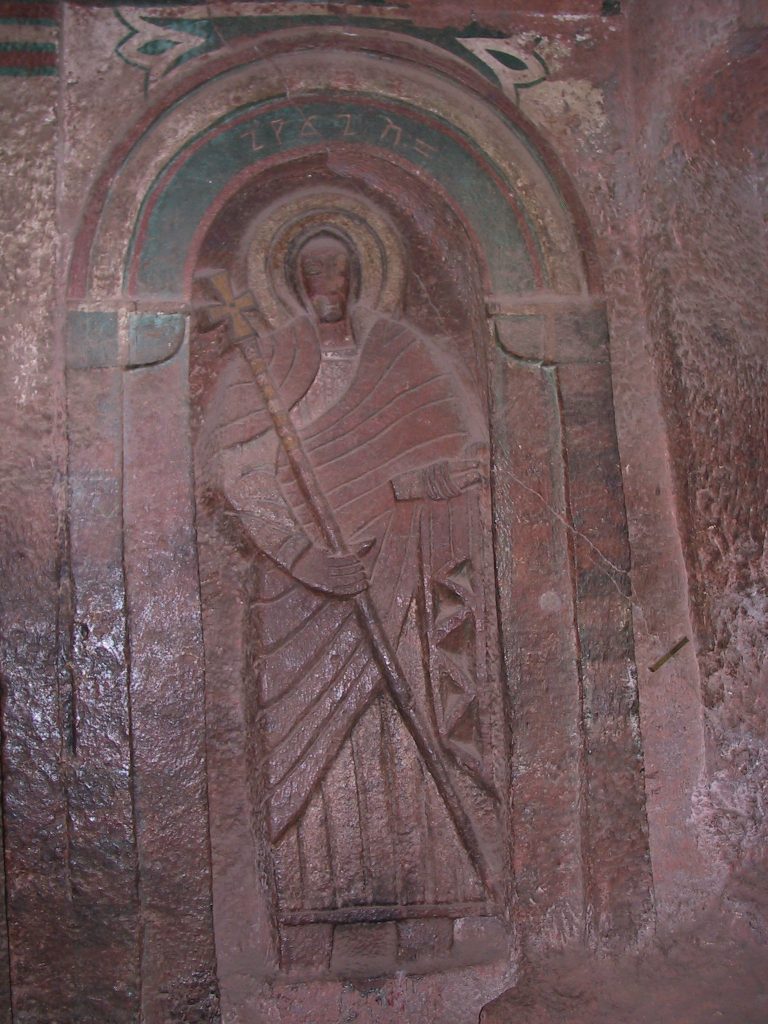
Various saints are depicted on the walls.
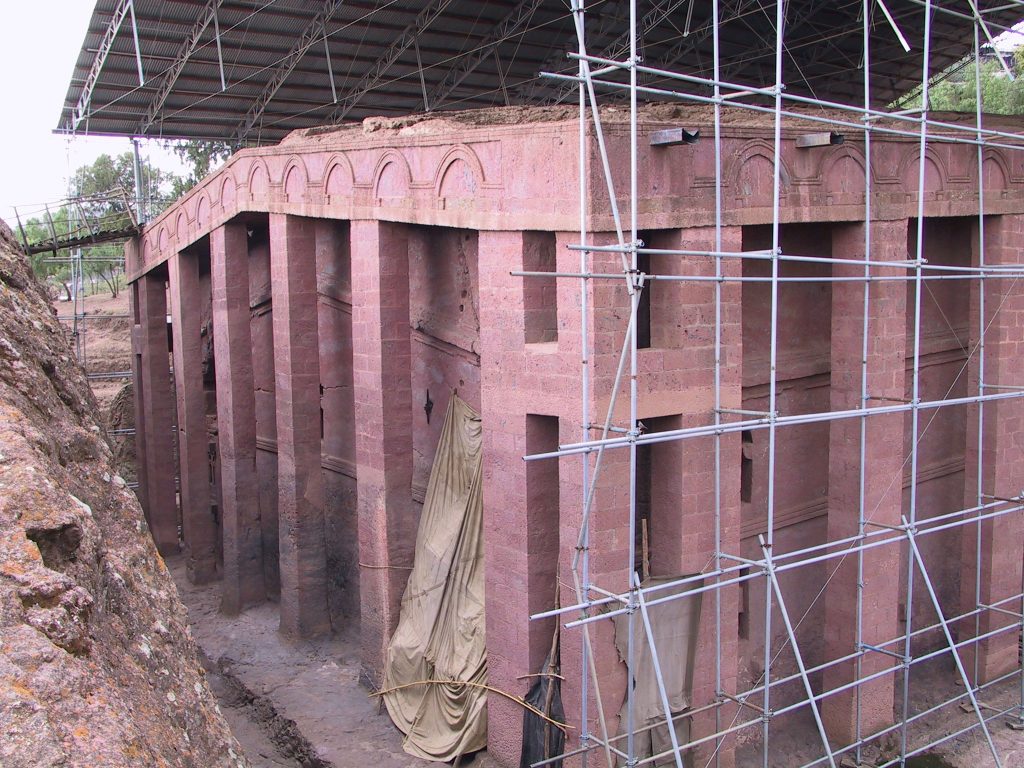
This is the biggest church. It was restored in 1954 by the Italians, who virtually destroyed it in WWII when they occupied Abyssinia as it was known then. I didn’t think Italians would stoop to mindless vandalism of historical buildings, considering their own history, but then a lot of similar mindless destruction occurred during that war by all the participants.

The road from Lalibella to Bahir Dar is all dirt. It had been raining for the past few days, and it continued raining along most of the way, albeit lightly. The road was very rocky and slippery. My front tire really took a beating from the rocks, and was covered in nicks and pieces missing. I had a real stroke of luck along the way. This road is very remote, and fuel is double the price of Addis Ababa. I was trying to get to Bahir Dar without refueling, but I decided to be safe and pulled into the only fuel station I had seen on the trip. As I pulled up, one of the locals pointed at the motor. I didn’t know what he was on about for a while, but when I looked, I saw that the fuel hose had fallen off one side of the tank, and fuel was pouring all over the ground. I quickly turned it off, and wondered how much I had lost. As it turns out, I hadn’t lost more than a litre, which means it had only just happened. If the fuel station wasn’t there, I would have been stuck in the middle of nowhere with no fuel. Another few minutes is all it would have taken. The fuel station only sold diesel, and he didn’t know how far it was to the next petrol, so I took it easy for a while to maximise the fuel economy. About 100km down the road I found fuel fortunately, but at an extortionate price.
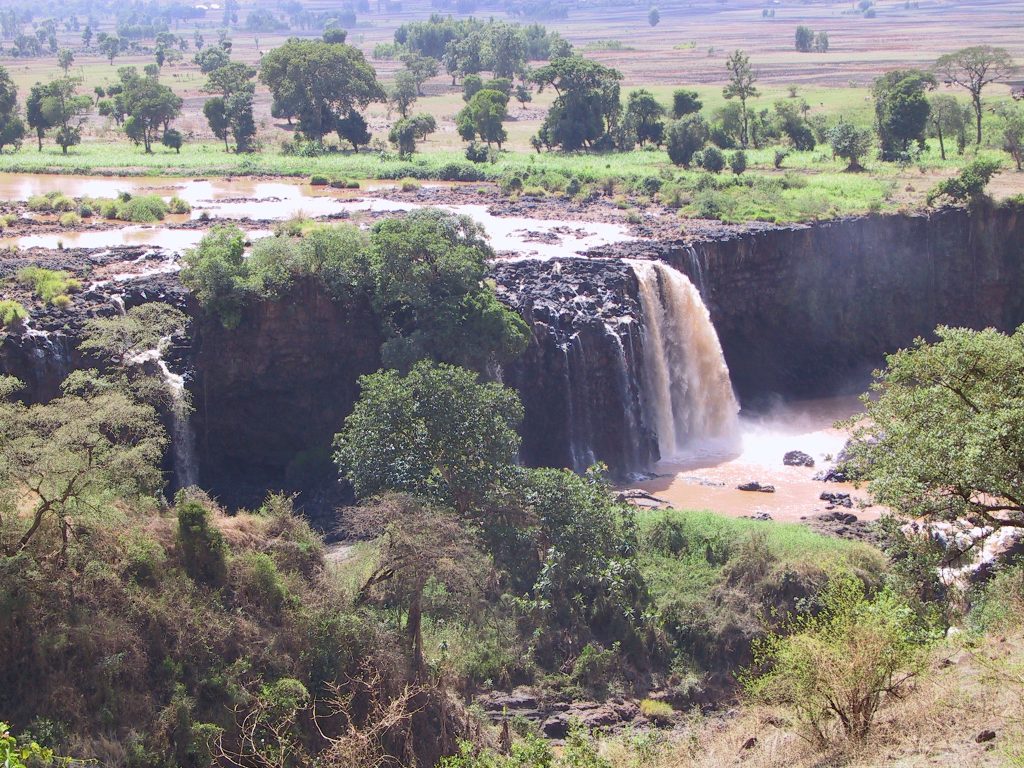
Take this one off your list of things to see. This is the Blue Nile Falls, 30km from Bahir Dar. It was the second biggest falls in Africa after Livingstone, but most of the water is now diverted to a hydro-electric power station (built by the Chinese and Yugoslav’s ???), leaving little more than a trickle running over the falls.
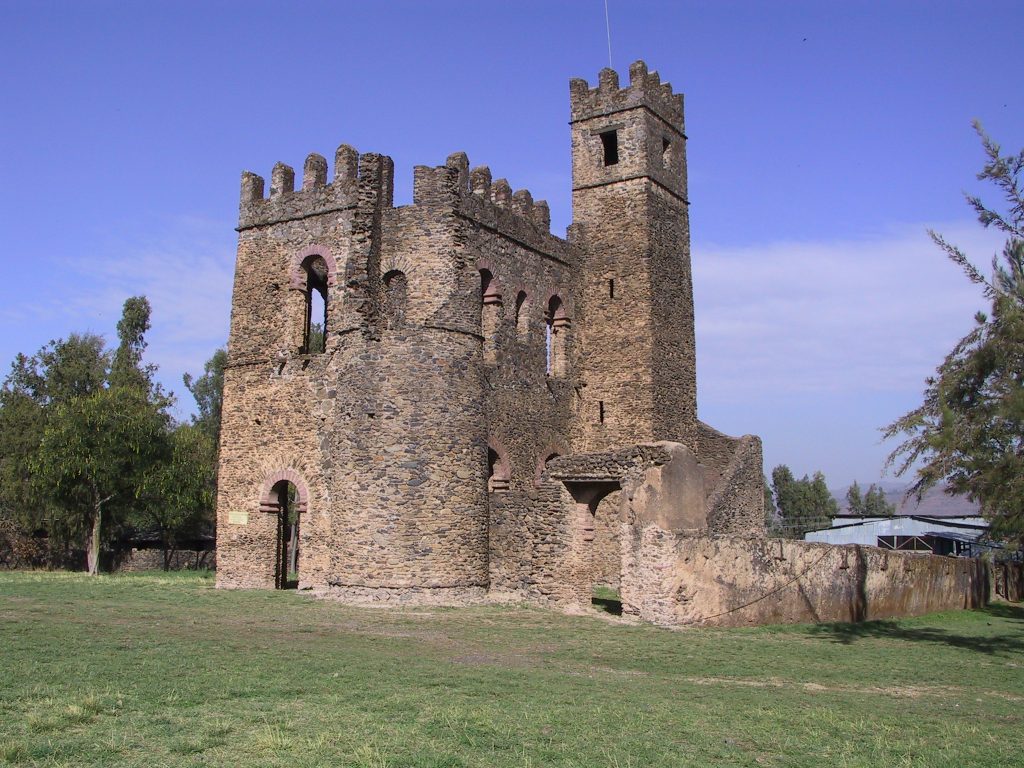
The historical town of Gonder.
